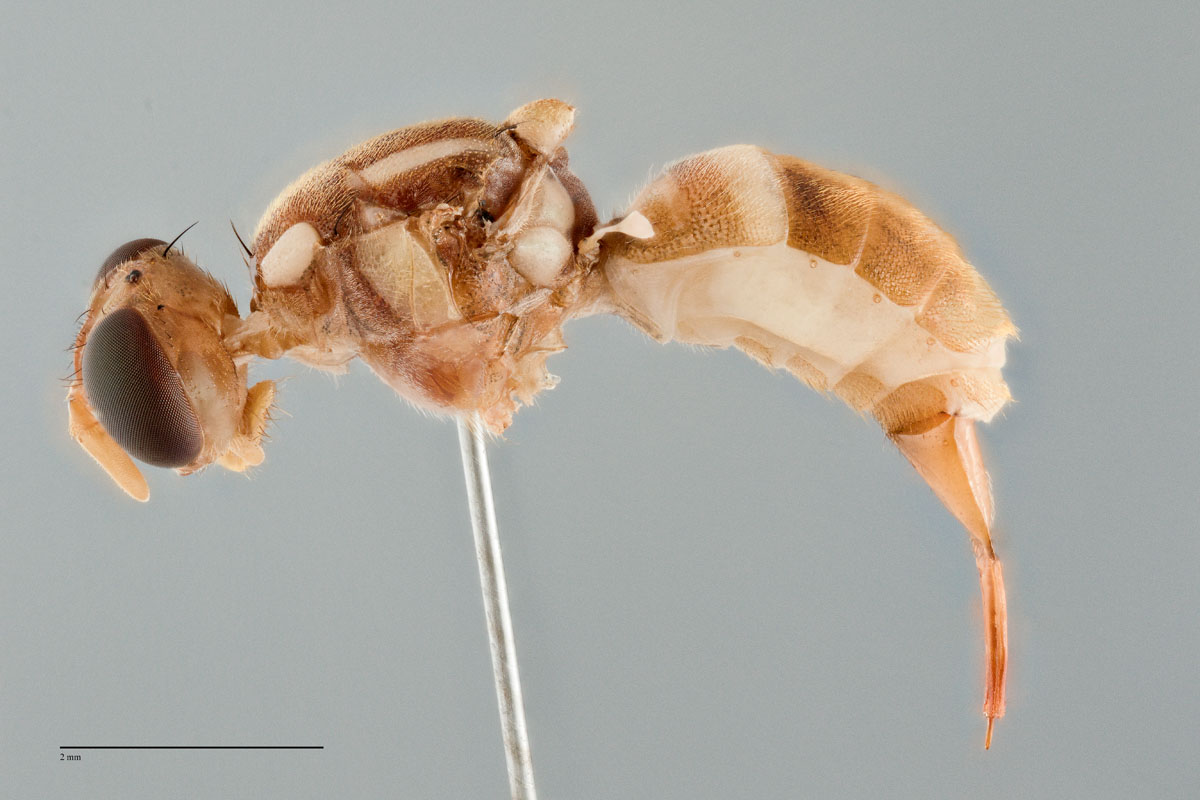Diagnosis
Morphological – adult
Medium sized species. Features include:
- small fuscous to black facial spots present
- postpronotal lobes and notopleura yellow
- scutum orange-brown without dark markings, mesopleural stripe reaching almost to anterior npl. seta, lateral postsutural vittae beginning anterior to mesonotal suture, broad medial postsutural vitta present, scutellum yellow
- wing with a narrow fuscous costal band and anal streak, cells bc and c pale fulvous (cell c slightly paler than cell bc), microtrichia in outer corner of cell c only
- abdominal terga I and II orange-brown, terga III-V fulvous except for two broad lateral longitudinal orange-brown bands over all three terga and a narrow medial longitudinal band which is orange-brown on tergum III and orange-brown to dark fuscous on tergum IV and V (this band is broader on tergum V)
- posterior lobe of male surstylus long
- female with aculeus tip blunt trilobed (Drew 1989; pers. comm. Drew 2010).
Morphological – larvae
See White and Elson-Harris 1992 p. 172
Molecular
DNA barcoding
Diagnostic BOLD reference data available.
COI data
Z. cucumis CUM001 Classic morphology Folmers COI
Z. cucumis CUM003 Abdomen variation Folmers COI
Z. cucumis CUM004 Abdomen variation Folmers COI
RPA2 data
Z. cucumis CUM001 Classic morphology RPA2
Z. cucumis CUM003 Abdomen variation RPA2
Z. cucumis CUM004 Abdomen variation RPA2
DDOSTs2 data
Z. cucumis CUM001 Classic morphology DDOSTs2
Z. cucumis CUM003 Abdomen variation DDOSTs2
Z. cucumis CUM004 Abdomen variation DDOSTs2
POP4 data
Z. cucumis CUM001 Classic morphology POP4
Z. cucumis CUM003 Abdomen variation POP4
Z. cucumis CUM004 Abdomen variation POP4
EIF3L data
Z. cucumis CUM001 Classic specimen EIF3L
Z. cucumis CUM003 Abdomen variation EIF3L
PCR-RFLP Test 1
BsrI: Does not cut
HinfI: Does not cut
HhaI: 550, 180
Sau3AI: Does not cut
SnaBI: Does not cut
SspI: Does not cut
Vspl: Does not cut
Aproximate ITS1 fragment length – gel: 750 bp
PCR-RFLP Test 2
DraI, RsaI and SspI produce diagnostic restriction patterns (See Restriction enzyme haplotype chart and Diagnostic restriction patterns).
DraI: 1250, 200, 120
RsaI: 570, 410, 300, 290
SspI: 880, 650











